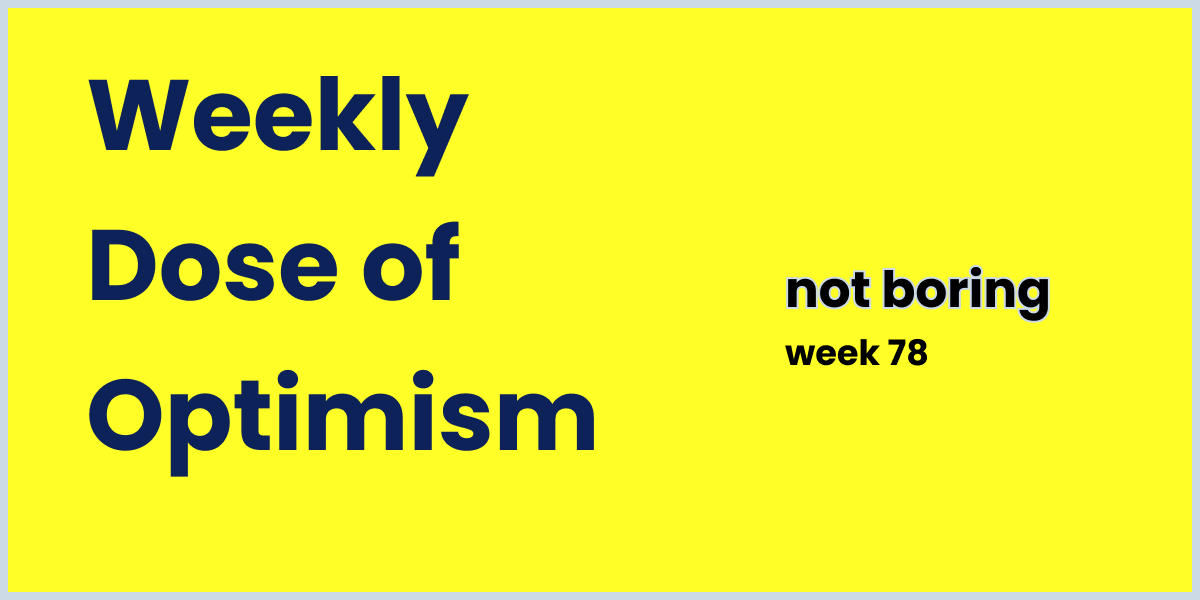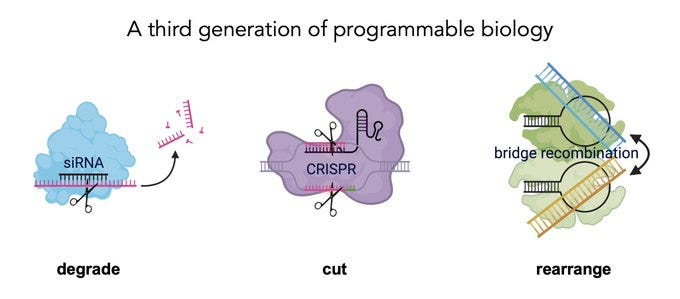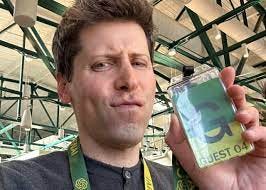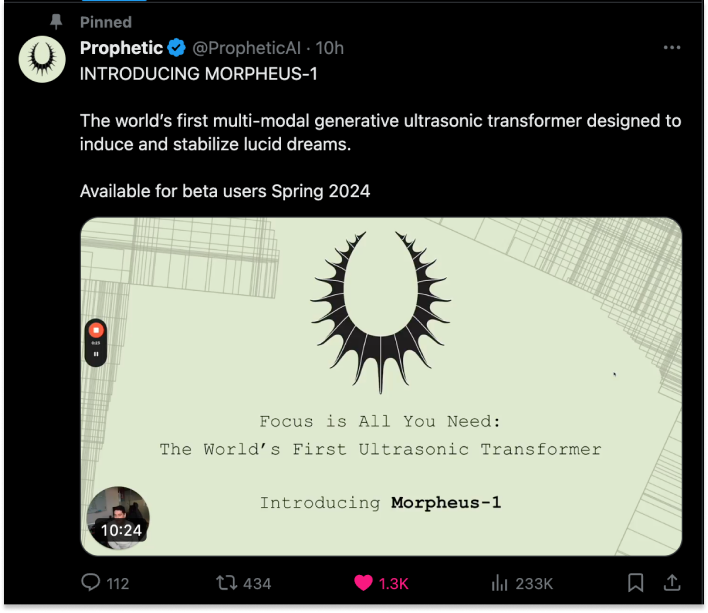

Weekly Dose of Optimism #78
source link: https://www.notboring.co/p/weekly-dose-of-optimism-78
Go to the source link to view the article. You can view the picture content, updated content and better typesetting reading experience. If the link is broken, please click the button below to view the snapshot at that time.

Weekly Dose of Optimism #78
Read Write Own, Gene Therapy, CAR T Cells, Bridge RNA, sama Chips, Prophetic
Hi friends 👋,
Happy Friday and welcome back to our 78th Weekly Dose of Optimism. After reading this week’s edition, you’ll be calling me Gene Hackman.
Let’s get to it.
Today’s Not Boring is brought to you by… Alto
Join the hundreds of Not Boring readers who are already exploring Alto Marketplace this year. With Alto, you’ve got options. Its self-directed IRA platform lets you invest in a range of alternative assets across private equity, venture capital, real assets like farmland and fine wine, cryptocurrency, private startup angel deals, and more. Better yet, investing in alts with dollars earmarked for retirement means you can make long-term and tax-advantaged decisions. Here are the top three reasons why Alto is a no-brainer:
IRA Capital: So many people leave money on the table by not investing through an IRA. Alto makes investing, tracking, and saving through a self-directed IRA easy.
Horizon Matching: Investing with an SDIRA and investing in alts are both long-term decisions.
Investment Options: If you’re already investing in alts or want to allocate more to them, Alto offers a full menu of alts through its investment platform partners that are usually inaccessible to retail investors.
Plus, you can now also check out the new Alto Marketplace – the premier destination for discoverability-driven securities investing. As we start off the New Year, make a good decision and learn more about Alto.
Start Investing in Alts with Alto Today
(Of course, IRA rules and regulations apply, and you should seek advice from a tax professional when making investments. Alternative asset investments are inherently risky and are intended for sophisticated investors.)
(1) Read Write Own: Building the Next Era of the Internet
By Chris Dixon
Packy here. There’s a short list of people who have most influenced my writing at Not Boring: Ben Thompson, Tim Urban, and Chris Dixon are at the top of the list.
Back in February last year, I got to read an advanced copy of Tim Urban’s book, What’s Our Problem?, and shared my thoughts on it in the Weekly Dose. With the benefit of hindsight, the arguments he made seem prescient and correct.
Recently, Chris sent me an advance copy of his book, Read Write Own: Building the Next Era of the Internet, which goes on sale Tuesday. I ripped through it. With the benefit of hindsight, in a few years, the case he makes for blockchain networks will look prescient and correct.
Chris writes with a blend of history, technology, and philosophy, distilled into well-reasoned and timeless takeaways.
His essays from over a decade ago — The next big thing will start out looking like a toy, What the smartest people do on the weekend is what everyone else will do during the week in ten years, The idea maze — show up linked in Not Boring posts to this day. I referenced his 2018 post Why decentralization matters and the attract—>extract cycle he introduced in it in the first essay I ever wrote about crypto.
Over the past couple of years, I’ve gotten the chance to work with Chris and the a16z crypto team as an advisor. Their technology-focused perspective on crypto has helped me to remain optimistic about its potential through the market’s ups and downs and influenced the way I think and write about the space. I recently wrote Capitalism Onchained and Blockchains as Platforms after spending time with the team.
Read Write Own tells the history and future of the internet. It’s a no hype, well-reasoned case that blockchain networks are both necessary for a richer internet and inevitable. It focuses on the technology and business models — the “computer” as Chris calls it — instead of the token prices and wild swings — the “casino.” As a result, I think this is a book that, like the essays, will be as relevant in a decade as it is today.
If the best way to predict the future is to see the present clearly, this book is the best prediction of the future of crypto, and of the internet, that I’ve read.
As Chris writes, “Tales of fortunes won and lost are dramatic, easy to explain, and attention grabbing. In contrast, the technology story is nuanced, slow to develop, and requires historical context to understand. (That’s a big reason why I wrote this book.)” There’s no better person to write crypto’s story and divine its future.
Whether you already believe that crypto will be important or remain skeptical, I think you’ll come away more optimistic after reading Read Write Own. Order it.
I want everyone to read the book. I’ll buy copies for the first 10 people who tweet about it with the link or a cover of the image and tag me @packym.
(2) Gene Therapy Allows an 11-Year-Old Boy to Hear for the First Time
Gina Kolata for the New York Times
On Oct. 4, Aissam was treated at the Children’s Hospital of Philadelphia, becoming the first person to get gene therapy in the United States for congenital deafness. The goal was to provide him with hearing, but the researchers had no idea if the treatment would work or, if it did, how much he would hear.
The treatment was a success, introducing a child who had known nothing of sound to a new world.
You heard that right: Children’s Hospital of Philadelphia (CHOP) doctors used gene therapy to cure a case of congenital deafness. The therapy involved injecting a harmless virus carrying functional otoferlin genes into the cochlea of the ear to replace the mutated gene, with the goal of restoring hearing. And it worked! Prior to this, there was no biological or medical methods to correct the underlying genetic causes of inner ear dysfunction.
Once more: doctors used gene therapy to cure deafness. Science rocks.
This type of gene therapy could be used to treat other genetic hearing losses, but also has a wide array of potential applications across other genetic disorders like cystic fibrosis, muscle dystrophy, hemophilia, and a number of other common and rate genetic disorders.
Fun little aside here: when I was 2 years old, CHOP doctors saved my life. I had an atrial septal defect — a hole in my heart — that required pretty invasive and risky surgery. The procedure went flawlessly and here I am today with a pretty decent heart as far as I can tell. So whenever I have the opportunity to amplify CHOP doctors’ work, I am going to to it.
Amor et al in Nature
Unlike small molecules, CAR T cells only require that the target antigen is differentially expressed on target cells compared to normal tissues; moreover, as ‘living drugs’, these therapeutics have the potential to persist and mediate their potent effects for years after single administration12. We have shown that CAR T cells targeting the cell-surface protein uPAR, which is upregulated on senescent cells, can efficiently deplete senescent cells in young animals and reverse liver fibrosis.
Someone make sure Bryan Johnson reads this research! The study developed a therapy using a type of engineered T cells called "CAR T cells” that are designed to target and eliminate senescent cells. Senescent cells are aged cells that have stopped dividing and can no longer perform their normal functions, and they contribute to aging s by releasing harmful substances that can damage nearby healthy cells. So if you eliminate the senescent cells, you can slow the aging processes.
The research is still early — the findings are currently limited to animal models — but is promising in terms of future applications in age-related conditions and metabolic diseases. The mice that underwent the treatment experienced improved exercise capacity and metabolic function after just one dose. And interestingly, young mice that received the treatment experienced a delay in the onset of age-related symptoms — meaning the treatment could be preventative in nature.
Longevity research is getting wild. What do we think the average lifespan of a child born in 2024 will be? Over/under 100?
(4) Bridge RNAs direct modular and programmable recombination of target and donor DNA
h/t Patrick Hsu of Arc Institute
We demonstrate that the target-binding and donor-binding loops can be independently reprogrammed to direct sequence-specific recombination between two DNA molecules.
What a big week for gene editing, huh?
Researchers discovered a new class of structured non-coding RNAs. These RNAs, named "Bridge RNAs," bind specifically to their encoded recombinase and allow for precise programming. Bridge RNAs are structured non-coding RNAs that facilitate sequence-specific recombination of DNA by independently base-pairing with both target and donor DNA, directing modular and programmable genetic rearrangements.
In more simple language, Bridge RNAs enable genetic modifications without the need for DNA double-strand breaks, which are typically associated with traditional genome editing techniques like CRISPR. This reduces the risk of unintended genetic damage and allows for greater precision in gene editing, insertion, and deletion.
(5) Altman Seeks to Raise Billions for Network of AI Chip Factories
By Edward Ludlow, Dina Bass, Gillian Tan, and Rachel Metz for Bloomberg
OpenAI Chief Executive Officer Sam Altman, who has been working to raise billions of dollars from global investors for a chip venture, aims to use the funds to set up a network of factories to manufacture semiconductors, according to several people with knowledge of the plans.
IT’S TIME TO FAB. Bloomberg reported this week that OpenAI CEO Sam Altman was in talks with a number of global investors to raise significant capital to build a network semiconductor manufacturing facilities, that could take on the likes of TSMC, Samsung, and Intel. Beyond the obvious size of the prize — TSMC and Intel are worth a combined ~$750B — Altman is reportedly motivated by his concern is that AI chip demand will outpace AI chip supply, which would hinder AI deployment and progress.
Details are still sparse, but I’ll share a few thoughts here:
US-Based: Presumably, Altman will not build this network of fabs in Taiwan or elsewhere within the sphere of China’s influence. Another scaled semiconductor fab under complete U.S. control is a major win of American national security.
First Customer: Demand for Altman’s chips, should they be near parity with other options on the market, should not be an issue. First, OpenAI is or will be in the near future one of the largest AI chip customers in the world. It helps when your founder is also the now-untouchable CEO of your largest potential customer. Second, if Altman is right and AI continues to grow at unprecedented rates of adoption, demand generally shouldn’t be an issue.
Altman’s Big Bets: We can now add chip manufacturing to Altman’s list of big bets. He’s behind the (arguably) leading startups in AI, crypto, fusion, and longevity. Sam makes big bets and chip manufacturing is no exception.
As noted, still super early stages here and we’re excited to follow this story as it develops. If it does happen, we can add it to the growing list of Techno-Industrial startups changing the world with bits and atoms.
Bonus: Prophetic Introduces Morpheus-1
Packy here. All those chips Sama is building are going to do more than just chat.
A startup called Prophetic just released a model called Morpheus-1. As the company tweeted: “Unlike LLMs, Morpheus-1 is not prompted with words and sentences but rather brain states. And instead of generating words, Morpheus-1 generates ultrasonic holograms for neurostimulation to bring one to a lucid state.”
In other words, it reads your brain state and sends back ultrasonic signals to induce lucid dreams. I’ve never lucid dreamed, but it sounds magical: you become aware that you’re dreaming, and can even control the characters, narrative, and environment in the dream. Virtual reality, on steroids, inside your own mind.
I suspect that as we push the limits of computers’ brains, we’ll also want to more deeply explore our own. Morpheus-1 is a step towards making that dream a reality.
That’s all for this week. If you have some time this weekend, check out Alto.
We’ll be back in your inbox on Tuesday.
Thanks for reading,
Dan + Packy
Recommend
About Joyk
Aggregate valuable and interesting links.
Joyk means Joy of geeK






